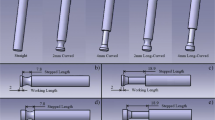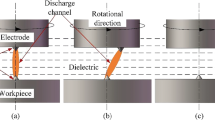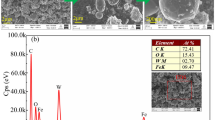Abstract
In the electrical discharge machining (EDM) of deep holes, electrode wear may cause the dimensions of the finished holes to deviate from their design values. In practice, the extent of the electrode wear and the surface roughness of the machined holes depend not only on the EDM machining parameters (e.g., the pulse duration, the pulse current, and so on), but also on the electrode route motion. Accordingly, the present study performs an experimental investigation into the effects of three different electrode routes (straight dip, spiral attack hole, and awl free expand hole) on the electrode wear and surface roughness of the machined holes in the EDM machining of PDS5A and PDS-1 mold steel, respectively. Overall, the experimental results show that of the three electrode route motions, the awl free expand hole motion results in a more uniform wear of the electrode and a lower surface roughness of the machined hole.

Similar content being viewed by others
References
Luis C.J., Puertas I., Villa G.: Material removal rate and electrode wear study on the EDM of silicon carbide. J. Mater. Process. Technol. 164(−165), 889–896 (2005)
Marafona J.: Black layer characterization and electrode wear ratio in electrical discharge machining (EDM). J. Mater. Process. Technol. 184, 27–31 (2007)
Kunieda M., Kobayashi T.: Clarifying mechanism of determining tool electrode wear ratio in EDM using spectroscopic measurement of vapor density. J. Mater. Process. Technol. 149, 284–288 (2004)
Zhao J., Li Y., Zhang J., Yu C., Zhang Y.: Analysis of the wear characteristics of an EDM electrode made by selective laser sintering. J. Mater. Process. Technol. 138, 475–478 (2003)
Kunieda M., Kameyama A.: on decreasing tool wear in EDM due to arc spots sliding on electrodes. Precis. Eng. 34, 546–553 (2010)
Mohri N., Suzuki M., Furuya M., Saito N., Kobayashi A.: Electrode wear process in electrical discharge machining. Ann. CIRP. 44(1), 165–168 (1995)
Lin, J.L.; Wang, K.S.; Yan, B.H.; Tarng, Y.S.: Optimization of the electrical discharge machining process based on the Taguchi method with fuzzy logics. J. Mater. Process. Technol. 102, 48–55 (2000)
Chen, S.L.; Yan, B.H.; Huang, F.Y.: Influence of kerosene and distilled water as dielectrics on the electric discharge machining characteristics of Ti-6Al-4V. J. Mater. Process. Technol. 87, 107–111 (1999)
Mahardika M., Tsujimoto T., Mitsui K.: A new approach on the determination of ease of machining by edm processes. Int. J. Mach. Tools Manuf. 48, 746–760 (2008)
Rhoney B.K., ShihA.J. , Scattergood R.O., Ott R., McSpadden S.B.: Wear mechanism of metal bond diamond wheels trued by wire electrical discharge machining. Wear 252, 644–653 (2002)
Wang C.C., Lin Y.C.: study of electrical discharge machining for W/Cu composite. Int. J. Refract. Metals Hard Mater. 27, 872–882 (2009)
CNC EDM operation catalogue Yihawjet Enterprises Co., LTD, Taiwan (2002)
Author information
Authors and Affiliations
Corresponding author
Rights and permissions
About this article
Cite this article
Chen, DC., Wang, YK. & Lin, GF. Effect of Electrode Route Motion on Electrode Wear in EDM Machining of Mold Steel. Arab J Sci Eng 38, 2793–2800 (2013). https://doi.org/10.1007/s13369-012-0486-9
Received:
Accepted:
Published:
Issue Date:
DOI: https://doi.org/10.1007/s13369-012-0486-9




